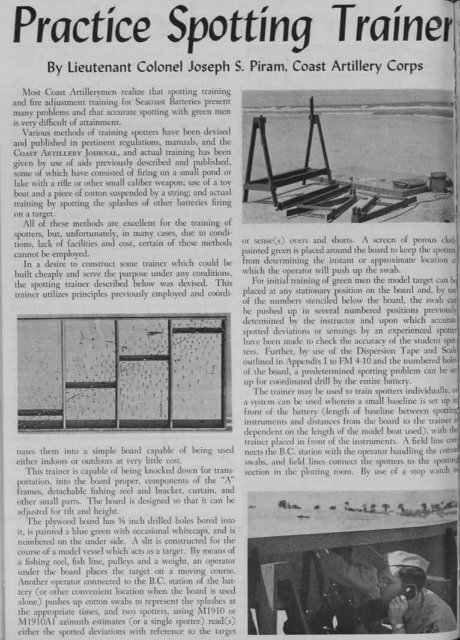July-August - Air Defense Artillery School
July-August - Air Defense Artillery School
July-August - Air Defense Artillery School
Create successful ePaper yourself
Turn your PDF publications into a flip-book with our unique Google optimized e-Paper software.
Practice Spotting Trainer:<br />
By Lieutenant Colonel Joseph S. Piram: Coast <strong>Artillery</strong> Corps !:<br />
i\ lost Coast <strong>Artillery</strong>men realize that spotting training<br />
and fire adjustment training for Seacoast Batteries present<br />
many problems and that accurate spotting with green men<br />
is very difficult of attainment.<br />
Va~ious methods of training spotters have been devised<br />
and published in pertinent regulations, manuals, and the<br />
COAST ARTILLERY JOURNAL, and actual training has been<br />
given by use of aids previously described and published,<br />
some of which have consisted of firing on a small pond or<br />
lake with a rifle or other small caliber weapon; use of a toy<br />
boat and a piece of cotton suspended by a string: and actual<br />
training by spotting the splashes of other batteries firing<br />
on a target.<br />
All of these methods are excellent for the training of<br />
spotters, but, unfortunately, in many cases, due to conditions,<br />
lack of facilities and cost, certain of these methods<br />
cannot be employed.<br />
In a desire to construct some trainer which could be<br />
built cheaply and serve the purpose under any conditions,<br />
the spotting trainer described below was devised. This<br />
trainer utilizes principles previously employed and c06rdi-<br />
\<br />
I<br />
~ t<br />
' ..<br />
nates them into a simple board capable of being used<br />
either indoors or outdoors at very little cost.<br />
This trainer is capable of being knocked down for transportation,<br />
into the board proper, components of the "A"<br />
frames, detachable fishing reel and bracket, curtain, and<br />
other small parts. The board is designed so that it can be<br />
ad justed for tilt and height.<br />
The plywood board has }s inch drilled holes bored into<br />
it, is painted a blue green with occasional whitecaps, and is<br />
numbered on the under side. A slit is constructed for the<br />
course of a model vessel which acts as a target. By means of<br />
a fishing reel, fish line, pulleys and a weight, an operator<br />
under the board places the target on a moving course.<br />
Another operator connected to the B.G station of the batterv<br />
(or other convenient location when the board is used<br />
alo'ne) pushes up cotton swabs to represent the splashes at<br />
the appropriate times, and two spotters, using 1\ 1191 0 or<br />
i\1191OAl azimuth estimates (or a single spotter) read(s)<br />
either the spotted deviations with reference to the target<br />
or sense(s) overs and shorts. A screen of porous cloth<br />
painted green is placed around the board to keep the spottef\<br />
from determining the instant or approximate location at<br />
which the operator will push up the swab.<br />
For initial training of green men the model target can Ix<br />
placed at any stationary position on the board and, by uS(:<br />
of the numbers stenciled below the board, the swab c-an<br />
be pushed up in several numbered positions previoush<br />
determined by the instructor and upon which accurate<br />
spotted deviations or sensings by an e~l)erienced spoue!<br />
have been made to check the accuracy of the student spot<br />
tel's. Further, by use of the Dispersion Tape and Scale<br />
outlined in Appendix I to Fl\l +10 and the numbered holeof<br />
the board, a predetermined spotting problem can be se'<br />
up for co(irdinated drill by the entire battery.<br />
The trainer may be used to train spotters indi\'idually. or<br />
a system can be used wherein a small baseline is set up in<br />
front of the hattery (length of baseline between spottin~<br />
instruments and distances from the board to the trainer i,<br />
dependent on the length of the model boat used), with the<br />
trainer placed in front of the instruments. A field line con<br />
nects the B.G station with the operator handling the cotton<br />
swabs, and field lines connect the spotters to the spotti~4<br />
section in the plotting room. By use of a stop watch Inl
















